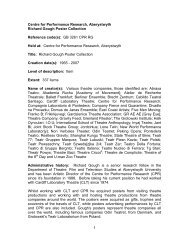IGES Newsletter Issue 2 - Aberystwyth University
IGES Newsletter Issue 2 - Aberystwyth University
IGES Newsletter Issue 2 - Aberystwyth University
You also want an ePaper? Increase the reach of your titles
YUMPU automatically turns print PDFs into web optimized ePapers that Google loves.
NEW MEMBERS OF STAFF<br />
<strong>IGES</strong> staff continues to grow!<br />
from Professor Martin Jones (Head of Department)<br />
As part of our continued expansion as a world-class research and teaching centre in<br />
Geography and Earth Science, we are very pleased to introduce the following new staff,<br />
who joined <strong>IGES</strong> since the last <strong>Newsletter</strong>:<br />
Dr James Brasington joined <strong>IGES</strong><br />
this January from the <strong>University</strong> of<br />
Cambridge as a Reader in Physical<br />
Geography. His academic interests focus<br />
on the development of numerical models<br />
and earth observation techniques to<br />
study and predict the behaviour of<br />
catchment and fluvial systems over a<br />
wide range of time and space scales.<br />
Geographically his research spans a<br />
diverse range of environments from the<br />
hot and dry (Iraq, California) to the warm<br />
and wet (Nepal) and the cool and humid<br />
(Scotland, New Zealand). Outside work, James is a keen hill walker, enjoys<br />
running and has recently turned to triathlon, although is struggling not to<br />
drown in the process! He is looking forward to moving from the flatlands of<br />
East Anglia to finally see some hills from his window!<br />
Professor Mathew Hannah joins <strong>IGES</strong><br />
this summer from the <strong>University</strong> of<br />
Vermont (Burlington, Vermont, USA) as<br />
a Professor in Human Geography. Matt’s<br />
primary research interests concern the<br />
ways in which modern forms of power,<br />
knowledge and territorial organization<br />
constitute each other and underpin<br />
Western social orders. His studies have<br />
focused on the spatial prerequisites for<br />
administrative control of Native Americans by the US Government in the<br />
late 19th century, the modernization of the US Census as both a symbol and<br />
a vehicle of new forms of spatial governance during that time period, and<br />
most recently, West German Census boycott movements in the 1980s as a<br />
window on emergent forms of citizenship appropriate to the ‘Information<br />
Age’. Away from the office, he is an avid walker and near-fanatical, year-round<br />
disc golfer.<br />
Glacier Web (www.glaciers-online.net)<br />
With support from UWA’s Teaching Innovations Fund, Professor Mike<br />
Hambrey (mjh@aber.ac.uk) of <strong>IGES</strong>, has been working jointly with Dr<br />
Juerg Alean from Zurich, Switzerland, to develop an educational website<br />
about glaciers (www.glaciers-online.net).<br />
The website is based on their very successful book (Hambrey &<br />
Alean, Glaciers, Cambridge <strong>University</strong> Press) and includes most of the<br />
photographs published therein. The site is hosted by ‘SwissEduc’, which<br />
is a rapidly expanding site covering geography and other academic<br />
disciplines. It is supported by charitable foundations in Switzerland. The<br />
purpose of the website is to help secondary level and university students<br />
4<br />
Dr Allen Hubbard joined <strong>IGES</strong> this<br />
January as a Lecturer in Physical<br />
Geography. Allen is interested in<br />
the links between glaciers and<br />
ice sheets and global climate on<br />
a variety of temporal and spatial<br />
scales. Allen’s particular expertise<br />
focus on the collection and use<br />
of field-measurements to train<br />
high-resolution, 3D models of<br />
climate, ice sheet and geophysical<br />
dynamics to help unravel the<br />
multitude of interactions and feedbacks which govern this aspect of the<br />
earth-system and which can lead to complex, non-linear responses and<br />
rapid environmental change. Allen has been most fortunate to have been<br />
able to combine some of these research themes with a passion for highlatitude<br />
sailing and mountaineering. In the last 7 years he has been sailing off<br />
in his own steel ketch, which has taken him from the Arctic to the Antarctic<br />
and lots of very pleasant (and warm!) places in between. For those of you<br />
wondering; yes, Allen is the brother of <strong>IGES</strong>’s Dr. Bryn Hubbard, and yes they<br />
are both great glaciologists.<br />
Dr Damià Vericat joined <strong>IGES</strong> this<br />
January, from the Forestry and<br />
Technology Centre of Catalonia<br />
(Spain) as a Post-Doctoral Researcher<br />
for the Centre for Catchment and<br />
Coastal Research. Damià is a fluvial<br />
geomorphologist whose research is<br />
primarily concerned with monitoring<br />
and modelling fluvial dynamics,<br />
especially sediment transport (bedload and suspended load) in gravel bed<br />
rivers, sediment and water management in regulated rivers, and fluvial<br />
hydrology. Recently his interest was focused on macroinvertebrate drift and<br />
bedload transport interactions in gravel patchy rivers in collaboration with<br />
the <strong>University</strong> of Lleida (Catalonia, Spain), the Forestry and Technology Centre<br />
of Catalonia (Catalonia, Spain) and the <strong>University</strong> of Aberdeen (Scotland, UK).<br />
Damià’s main hobbies are mountain biking, football, enjoying nice films in<br />
cinemas, and cooking.<br />
gain a visual appreciation of glaciers, glacial landforms and sediments,<br />
and their importance in the context of climate change. <strong>Aberystwyth</strong><br />
students are encouraged to use the site for glacier-related modules. The<br />
site is also used by university lectures world-wide to incorporate images<br />
into their own course, and some photographs have been used by BBC<br />
News Online. The website received a very positive review in the journal<br />
Science in 2005, which described it as ’a boon for visual learners’. The site<br />
continues to evolve – new additions last autumn included an illustrated<br />
glossary of glacial features, and a collection of Arctic photographers.


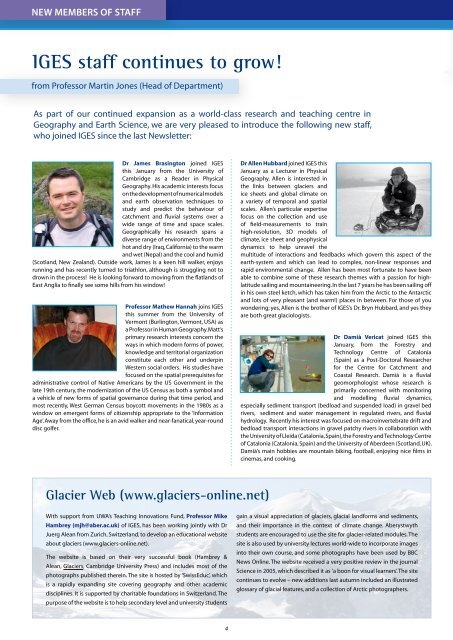
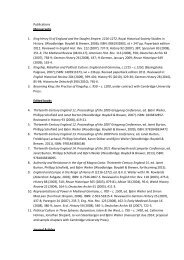
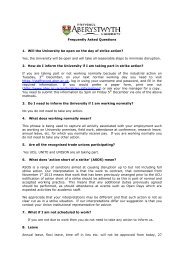




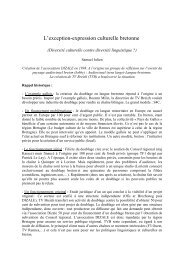

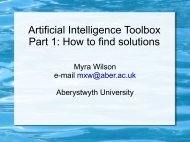
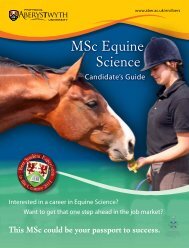

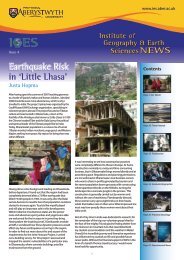
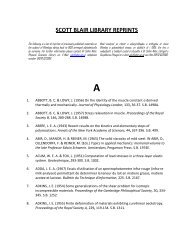
![[pdf] the council - Aberystwyth University](https://img.yumpu.com/8200062/1/184x260/pdf-the-council-aberystwyth-university.jpg?quality=85)
